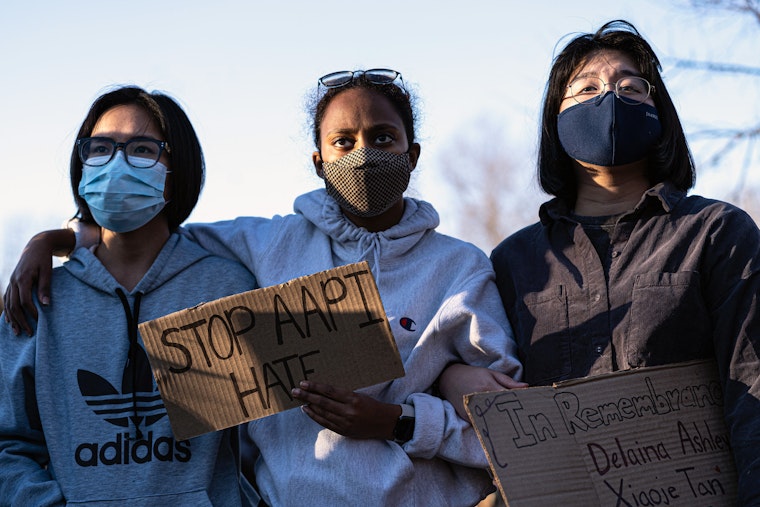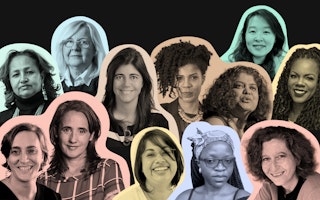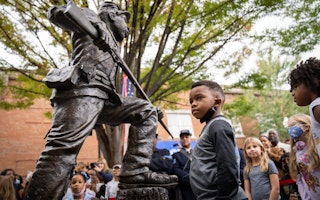A History of Anti-Asian Hate in the United States
By Laleh Ispahani & Kavita Nandini Ramdas

Last week, a white man targeted three Asian-run massage parlors in the Atlanta region, and killed eight people. Six of the victims were Asian women. We must never forget their names: Soon Chung Park (74), Hyun Jung Grant (51), Suncha Kim (69), Yong Ae Yue (63), Delaina Ashley Yaun (33), Xiaojie Tan (49) and Daoyou Feng (44). The victims were disproportionately older Asian women. They were sisters, mothers, and grandmothers—and all people who worked in low-wage jobs.
As two South Asian immigrant women living in the United States, these attacks are sadly familiar and hit home. These shootings, along with the marginalization of women by the junta in Myanmar, and the rise of gender-based violence in India and Latin America this past year, underscore a broader global crisis we all find ourselves in today.
While many in the media and law enforcement were quick to flatten the Atlanta shooter’s story to one motive, they ignored the most toxic intersecting factors plaguing society today and contributing to rampant violence: white supremacy, misogyny, permissive gun culture, and classism.
Last year, former President Donald Trump reinforced white supremacist narratives with his insinuations about the origins of COVID-19, which he termed “Chinese Virus.” Experts warned that his dehumanizing and xenophobic rhetoric would exacerbate the possibility of violent attacks in the midst of a global pandemic.
It turns out that words do indeed have consequences. We have watched in anger and dismay as Asians and people who appear Asian have become victims of a spate of violence across America. Between March 2020 and February 2021, Open Society grantee Stop AAPI Hate documented nearly 3,800 self-reports of anti-Asian hate incidents. Asian women were more than twice as likely to be attacked as Asian men.
These senseless murders also underscore the ways in which women, and particularly women of color and migrant women, are blamed or even killed because of their identity. Instead of looking to men’s lack of ability to deal with sexual rejection or shame, women are frequently blamed by virtue of what they wear—or in the case of the Atlanta shootings, simply because of who they are.
During a press conference, the police repeated the shooter’s own narrative of his alleged, “sex addiction,” without questioning the rampant hypersexualization of Asian women throughout U.S. history and in American culture and media. These stereotypes have perpetuated, and even normalized, misogynistic racism against Asian women. In particular, massage and spa workers that provide healing services. Whether or not they were actually sex workers or self-identified under that label, we know that as massage workers, they were subjected to violence stemming from the hatred of sex workers, Asian women, working-class people, and immigrants.
Recognizing the history of America’s sanctioned bigotry against people of Asian descent is an important starting place for the learning needed to prevent violence. After slavery was formally abolished in the United States, thousands of Chinese people were brought to the country to work in industries such as railroads, sugar plantations, and mining. America’s first immigration law, the Page Act of 1875, unapologetically excluded East Asian women from the country because of stereotypes that they were sex workers and “temptations for white men,” making their immigration illegal and barring existing Chinese-American women from becoming citizens. In 1882, the U.S. government also excluded Chinese men. Those laws were not repealed until 1943, a time that roughly coincided with President Franklin Delano Roosevelt establishing Japanese-American internment camps during World War II.
In 1933, mobs of white people attacked Filipino farmworkers after they were seen dancing with white women in Watsonville, California. The state later enacted a law to prohibit marriages between the two groups. And in 1934, Congress restricted Filipino immigration to the United States to just 50 people per year, even as the United States completed almost 40 years of military domination over the Philippines.
This discrimination expanded over time to include Islamophobia and anti-South Asian violence. After the September 11 attacks, the U.S. Congress passed the USA PATRIOT Act, which conflated immigration and national security policy, and forced 80,000 men from predominantly Arab and Muslim countries to register with the agency then called the Immigration and Naturalization Service. The NYPD and FBI were actively surveilling and harassing Muslims across New York City for years after the event.
Most recently, in 2017, former President Trump promised a “total and complete shutdown of Muslims entering the U.S.” While court challenges watered down the administration’s initial plans for the ban, people from Syria, Somalia, Yemen, Libya, Iran, North Korea, and Venezuela were barred from the country until President Joe Biden reversed the ban in an executive order earlier this year.
Ironically, Asians have been used politically in the United States, and across the globe, to create a middle ground between Black and white communities. In the 1980s, the stereotype of Asians as a “model minority” was consciously used to create hierarchies between Asians and Black Americans. Prominent leaders placed blame on the Black community for failing to escape systemic poverty and build wealth in comparison to selective immigrant success stories.
This myth also erases the real struggles faced by Asian communities. The harsh reality is that more than 12 percent of the Asian American population officially lives below the federal poverty level. These numbers do not include the informal economy (domestic workers or sex work) or the roughly 1.7 million undocumented community members.
Even in recent years, as mainstream society has begun to acknowledge the need to address white supremacy and systemic racism, Asians and Asian Americans are often left out of the conversation. The spike in racial scapegoating and hate crimes has now exposed the intimate connections between anti-Black and Asian racism, white supremacy, and xenophobia.
To end racist and sexist violence, the United States will need to recognize and embrace the diversity of all its communities as a strength. We see hope for this in a new administration, but we will need to keep civil society voices and movements strong to realize a truly open society here in the United States, and across the globe.

Laleh Ispahani is managing director of Programs at the Open Society Foundations.

Until September 2021, Kavita N. Ramdas was director of the Open Society Women’s Rights Program.


